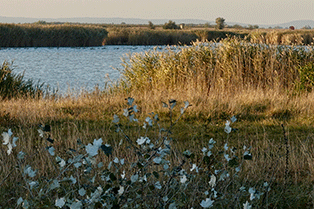
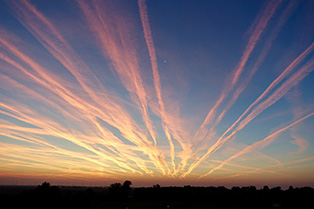
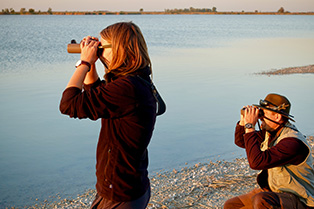
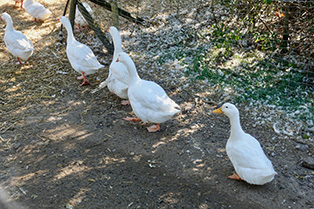
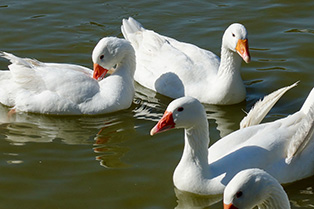
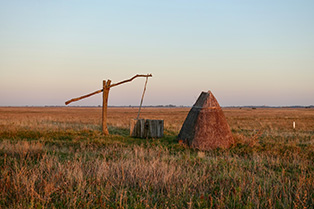
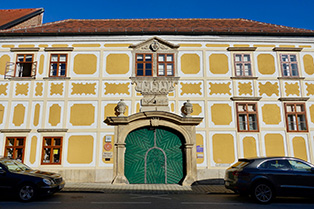
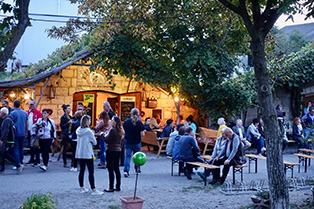

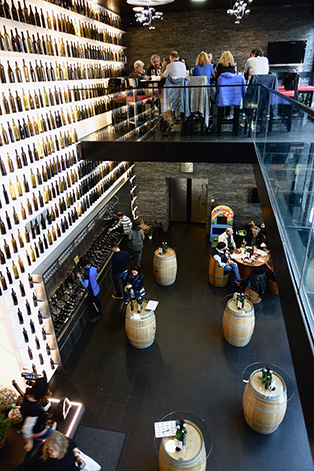



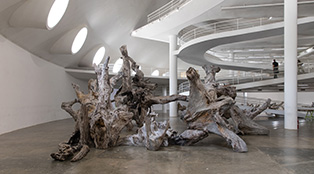

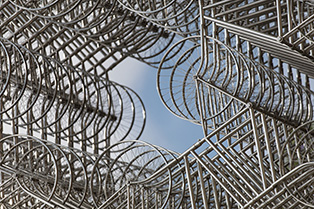
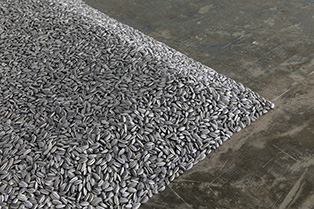
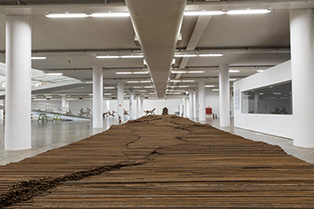
«Im Burgenland: Von Wein, Wild- und Weidegänsen»
Von Ingrid Schndler
Zur Zeit der Weinfeste ist im Burgenland die Gans bzw. das Gansl, wie man hier sagt, der Hit der Saison. Das kommt nicht von ungefähr, denn in der Pannonischen Tiefebene, die vom Neusiedler See, dem grössten Steppensee Europas, bis ins rumänische Banat reicht, ist die Hausgans zuhause.
«Sie prägte das Ortsbild im Burgenland und war omnipräsent», sagt Rangerin Denise Reiter. «Als in den 60ern der Höhenflug von Trute und Poularde begann, verschwanden die Gänseherden aus dem Landschaftsbild.» Dieses erinnert an Ungarn, zu dem das jüngste Bundesland Österreichs bis 1921 gehörte.
Vogelsafari im Seewinkel
Reiters Forschungsobjekt ist nicht die Haus-, sondern die Wildgans. Die Wildtier- und Verhaltensbiologin ist eine von 14 Rangern der St. Martins Therme und Lodge im Seewinkel, die Touristen ganzjährig die Natur des Nationalparks Neusiedler See-Seewinkel/ Fertö auf Safaris näherbringen. Mit Ungarn teilt sich das Burgenland nicht nur das warme pannonische Klima, die flache Steppenlandschaft, den Baustil, die Weingärten und Kulinaria, sondern auch den grenzübergreifenden Nationalpark, der seit 1993 unter dem Schutz des UNESCO Welterbes steht.
Für Birdwatcher ist das artenreichste Vogelgebiet in Mitteleuropa ein Paradies. Die einzigartigen Sodalacken (Salzseen), Niedermoore, Feuchtwiesen und Schilfzonen bieten Zugvögeln Nahrung und Brut-, Rast- und Überwinterungsplätze. Vom exotisch-bunten Bienenfresser bis zur Grosstrappe oder Waldohreule kann man rund 350 Vogelarten beobachten, allen voran die Graugans. Kein anderes Federvieh ist stärker mit der Region verbunden, so Reiter. Von der Bläss-, Rothals- oder Brandgans bis zur gefährdeten Zwerg-, Rost- oder Saatgans nutzen zahlreiche Arten die geschützten Schlafplätze auf dem Wasser und schneefreien Weiden im Winter. Hausgänse gehören ebenfalls zu den Graugänsen und fügen sich, wenn sie ausbrechen, in Wildgansverbände ein. «Nur sind sie wegen der weissen Federn gegenüber Feinden im Nachteil, da sie leicht auszumachen sind», findet die Rangerin.
Kommt ein Ganserl geflogen
Um der Hausgans ihre alte Heimat wiederzugeben, haben Bauern 2002 die «Genussregion Südburgenländische Weidegans» gegründet. Weil er viel zu oft viel zu schlecht Gans gegessen habe, ist Wolfgang Scheiblauer seit 2012 mit von der Partie. «Mastgänse aus dem Osten sind in 13 Wochen schlachtreif, Weidegänse erst in 25 bis 28 Wochen – sie sind fit statt fett». Die Tiere wachsen artgerecht ohne Zwangsfütterung im Freien auf, ernähren sich von Weidegras, Regenwürmern, Schnecken und wenig Hafer, haben viel Platz (ca. 80 m2/ Tier), können baden und theoretisch davonfliegen. Aber glückliche Gänse täten das nicht. Astrid Spiri vom Schweizer Züchterverein für ursprüngliches Nutzgeflügel bestätigt dies. Ihre Diepholzer Weidegänse fliegen nur, «wenn sie einen guten Grund haben, ein Hund oder Fuchs etwa in der Nähe ist oder Zugvögel vorbeiziehen. Aber sie kommen immer von allein zurück, wenn es ihnen gut geht.»
Innovation und Tradition: Ganslburger und Beuschel
So gut wie den Burgenländern geht es Schweizer Gänsezüchtern nicht, der Markt stagniert, die Nachfrage: bescheiden. Scheiblauer kennt beide Märkte, denn unter der Woche arbeitet der Landwirt, der zugleich Betriebswirt ist, als Finanzberater in der Schweiz, während sich seine Partnerin zuhause um die 6’500 Gänse kümmert. «Der Preisdruck durch Billiggänse aus Polen und Ungarn ist stark, der Absatz der teureren Weidegans funktioniert am besten über Events», ist er überzeugt. Deshalb hat er vor sechs Jahren das Genussfestival «Gans Burgenland» initiiert. Heute finden rund 30 Gansl-Feste im Herbst statt. Sein Ziel: Weidegänse nicht nur von Martini bis Weihnachten, sondern ganzjährig zu vermarkten und sie in der Schweiz populär zu machen. Einen Importeur hat er bislang noch nicht.
Um die Kunden bei der Stange zu halten, entwickelt Scheiblauer laufend neue Produkte. «Die Jungen gewinnt man nicht mit Gänsesuppe oder Beuschel, sondern mit Ganslburger oder -leberkäs (Fleischkäse).» Bei einem Galamenü für Schweizer Journalisten im ehemaligen Sommersitz der Fürsten Esterhazy über Eisenstadt zieht er alle Register der Gänseküche: Rillettes, Grammelschmalz, Paté aus gesunder, ungestopfter Leber, geräucherte Brust, Consommé, Beuschel (Magen, Lunge, Herz und Fleisch), das nach anfänglicher Skepsis sogar diejenigen loben, die bei Innereien abwinken, und als Krönung souvide gegarte, gebratene Keule, wie sie nicht zarter und saftiger sein könnte – alles aus eigener Herstellung. Die Weidegans überzeugt auf der ganzen Linie, der höhere Preis macht sich bezahlt.
Spitzenweine vom Neusiedler See
Der passende Wein aus dem fruchtbaren pannonischen Boden gehört zum Gänsebraten dazu. Erste Wahl ist ein fruchtig-würziger, harmonischer Zweigelt DAC, zweigelt-dominierte Cuvées aus den Ruster Rieden oder Blauer Zweigelt, eine Kreuzung aus Blaufränkisch und Sankt Laurent, dem populärsten Roten in Österreich. Zweigelt ist die die Hauptrebsorte des Burgenlands. Seine vielen, bekannten Geschmacksaromen an Zunge und Gaumen, wie Beeren, Kirschen, Sauerkirschen, machen ihn leicht zugänglich, seine milde Säure und schöne, klare Struktur leicht trinkbar – wie auch Pinot noir und St. Laurent. DAC steht für Districtus Austriae Controllatus und 100-ige Herkunftssicherheit. Mit 7’800 ha Rebfläche ist das Neusiedlersee DAC Gebiet das grösste mit geschützter Herkunft im Burgenland, 105 Winzer stehen dahinter, die alle ihre Türen für Verkostungen und Betriebsführungen öffnen, gegen Voranmeldung auch ausserhalb der fixen Öffnungszeiten.
Der Toptipp zu Gänseleber ist ein eleganter, frischer, fein-fruchtiger und nicht zu süsser Süsswein, wie die biodynamisch produzierte Pinot Cuvée von Feiler Artinger aus Rust am Neusiedler See – die Ruster Süssweine zählen zur Weltspitze. Das Ruster Kleinklima fördert die für Süsswein unerlässliche Edelfäule; ähnlich ideale Klima- und Bodenverhältnisse herrschen nur noch im ungarischen Tokaj und im französischen Sauternes vor.
Kultwein aus dem Hitzepol
Generell ist das Klima des Neusiedler See DAC-Gebiets perfekt für Rebkulturen. Das Weinwerk in Neusiedl am See weiss warum: kontinental-pannonisch-mediterran, geschützt vor Schlechtwetterfronten, mit der Thermik des Neusiedler Sees als Klimaregulator. Die Ostseite des Sees, der Seewinkel, ist mit 300 Sonnentagen die wärmste und sonnigste Region Österreichs. Die Temperaturunterschiede sind gross, die Sommertage heiss und trocken, die Nächte kühl, die Winter kalt und sehr schneearm – gut für den Wein.
In Andau, dem sonnigsten und wärmsten Ort Österreichs, im Osten der Seewinkels, ist das Weingut Scheiblhofer angesiedelt. Bis 1983 waren die Scheiblhofers Gemüsebauern; mit Süss- und Weisswein hat Vater Johann angefangen. Mit den Söhnen Erich, dem heutigen Kellermeister, und Harald, Weinwissenschaftler in Klosterneuburg, dem österreichischem Bundesamt für Wein- und Obstbau, hat Johann Scheiblhofer nach australisch-kalifornischem Muster auf Think Big gesetzt und sich mit Top-Rotweinen von unverwechselbarer Stilistik wie dem Big John und Legends einen weit übers Land hinausstrahlenden Ruf geschaffen. Die Tropfen des Kultwinzers, wie auch des ebenfalls in Andau ansässigen Hannes Reeh und anderer Weingrössen, stehen bei uns längst im Regal. Für Scheiblhofer ist die Schweiz Hauptexportland.
Die Genussreise wurde von Österreich Werbung und Burgenland Tourismus durchgeführt. Info: www.austria.info, www.burgenland.info
Die Adressen: Gans, Wein, Safaris und Kultur am Neusiedler See/ Burgenland
Anreise: Flug nach Wien, ca. 1 Stunde mit dem Zug nach Eisenstadt, mit dem Auto 8 Std., mit dem Zug 9,5 Std. von Zürich
ÜN: St. Martins Therme & Lodge, Frauenkirchen, www.st.martins.at; Vila Vita Pannonia, Pamhagen, www.vilavitapannonia.at; Seehotel Rust, www.seehotelrust.at
Essen: Die Alm by Rabina, Eisenstadt; Gowerl Haus, Illmitz; Hofgassl, Rust
Wein: Weinwerk Burgenland, Untere Hauptstr. 47, Neusiedl am See, umfangreichste Vinothek des Burgenlands mit fast 600 Weinen von über 150 Winzern, www.weinwerk-burgenland.at; Weingut Feiler Artinger, Rust am See, biodynamischer Weinbau, Spitzen-Süssweine, www.feiler-artinger.at; Weingut Scheiblhofer, Andau, Seewinkel, Kultweine wie der rote Big John, hochmodernes Weingut der Superlative, www.scheiblhofer.at; DAC-Weingüter Neusiedlersee, www.neusiedlersee.com, Kellergassen-Feste, Winzermenüs, «Pannonischer Herbst mit offenen Kellertüren» (Sept.-Dez.), , www.weinburgenland.at
Seewinkel-Safaris: verschiedenste Touren über St. Martins Therme & Lodge buchbar, siehe oben, z.B. Birdwatching, «Ein Jahr im Leben einer Graugans», Wassererlebnis-Safari, Individuelles Tiertraining, Grosstrappen-Safari, Genuss-Safari u.v.m. bzw. geführte Exkursionen durch das Nationalparkteam, www.nationalpark-neusiedlersee-seewinkel.at
Weidegänse: Südburgenländische Weidegänse, www.meineweidegans.at (19.50 €/ kg zzgl. 25 € Versand). Schweizer Weidegänse, www.weidegans.ch (30 – 35 Fr./ Kilo plus Versand)
Kultur: Classic Esterhazy, Klangfrühling auf Burg Schlaining, Kammermusikfest Lockenhaus, Haydn-Festival, Seedestspiele Mörbisch, Jennersdorfer Festivalsommer Jopera, Kultursommer und Burgspiele Güssing, Pannonisches Forum Kittsee u.a.
Info: www.austria.info, www.burgenland.info
«Exhibition Raíz Ai WeiWei at OCA São Paulo»
By Julieta Schildknecht
Ai WeiWei’s biggest exhibition, opens a week before 2nd round presidential election happens in Brazil. The show of 70 art pieces, some of which have been projected and made in Brazil, is curated by Marcello Dantas.
Marcello Dantas, five years of preparation for the exhibition of Ai WeiWei?
– No, longer, I saw his Sunflower Seeds exhibition at Tate Modern in 2010. I approached him for this project in 2011. We decided then to use a transformative process in the exhibition, to exhibit pieces made in Brazil. Five weeks after our initial meeting, Ai Wei Wei was arrested. We suspended the project until 2014. Once his Studio knew of the possibility of Ai Wei Wei leaving China, the project was actual again.
Was your intention to exhibit only in Brazil?
– Yes. But the project grew into showing in Argentina and Chile. Luckily due to a logistic convenience we started the exhibition in Argentina, then Chile and left Brazil, due to its historical roots, to the end of the program. Thats when I contacted the social designer Paula Dib, whom I know from other collaborative projects, to help with enumerating all the many regional handcraft technics and traditions for Ai Wei Wei. One doesn’t know which material he chooses to use. Everything is possible, his art piece can be created using wood, or ceramics or any material found in Brazil. Paula introduced the spectrum of different materials that are accessible in our country. The process of acculturation started then and we thought of using natural fibres, latex (caucho), leather, wood, ceramics…
Did he know already what he wanted to exhibit?
– He arrived first without any preconception absolutely free to any inspiring inputs.
Did the exhibition proposals come from you?
– It was a learning process to him because he was never before in South America.
Paula intervenes to say that they (Marcello and her) would introduce him to all that in a very personal way.
What were the priorities?
Paula says there were none.
– He wanted to see everything and it was interesting to work like that. When I had all the research very visible I would bring that to him and he would look at that from his own perspective. He would see something else, completely different from what was on that research. An astonishing surprise to me. It was always a transformative process. The environmental context would bring him somewhere, the social context somewhere else as well the political context, all unfolding to new ways of creation.
Ai Wei Wei decides to approach the subject slavery based on a photograph from the end of 19th century. The image is of a slave with a scarf on her face made with a hot iron. The scarf reminds the iron seals used on animals to determine their precedence. The artist decided to use cattle skin based on research made on the Amazon and its territorial expansion; on the historical importance of cattle in the Northeast of Brazil and the impact of sealing people (slaves) just like animals as property. The signs of property on the cow skin are taken from the Armorial Alphabet and the phrases are from Ariano Suassuna’s writing.
Ai Wei Wei’s comment is that he is a visual person and his wife, a cineast, edits his films and photographs. The history behind every visual image he uses is decisive and absolutely important to the scope of his work.
Marcelo intervenes to add:
– Lets not forget that Ai Wei Wei is a self-taught architect constantly constructing art pieces. He uses an architectonic language to build the elements that compose his projects. The process is experimental, initially quite intuitive to become extremely precise. It rises from nothing, no sketches, quite ethereal… His assistants follow a gesture and the entire process is filtered into a final and perfect object.
How did he engage with the Brazilian culture?
– With all the access we provided him, he of course could take profit of our rich culture.
Paula complements that Ai Wei Wei as a Chinese, was enchanted by such a broad diversity of materials he could find in Brazil. The artist is using for this exhibition a big spectrum of materials such as leather and wood which are considered in extinction in China.
– His first twenty years were spent in the desert, living in a hole on the desert intervenes Marcello Dantas. He was impressed by all the green and shades we have in our Nature. He was perplexed when he first saw a Jabuticabeira tree. He couldn’t believe how black she looked due to its fruits covering its branches and trunk.
– I would like to add that, the Anthropophagie process from Brazil with foreigners is quite old. There is a number of artists coming to Brazil, like Debret or Pierre Verge to name a few, artists travellers, who are impressed by our abundance and fertility and translate these especial influences into their work. This detail is part of art history and part of the identity of Brazil. We have been recognising ourselves through foreign views. It is part of our tradition. I would however say this particular process wasn’t a one way process for Ai WeiWei. Brazil, has also devoured him. There was a moment that pictures it well. In the middle of the Amazon, Ai WeiWei finds a tree trunk and first thing films his check mate with the Queen, a 35 meter dead tree trunk. It happened as a canibal chess game. The tree trunk was modelled in its nudity, in its entirety and length to be sent to his Studio in Germany. He accepts the King’s check mate and is modelled absolutely naked during hours until almost being asphyxiated. In the end the carnal exchange sucumbes in nothing because the real tree trunk remains in the Amazon and his body’s sculpture lies on a mattress overtaken by piles of seeds next to a body of a dread lock black lady sculpture. In conclusion Ai WeiWei sucumbes to the Brazilian Nativity and completes the art piece with an installation made of a diversity of Brazilian Ex votos. The best of art is when it happens unintentionally. He didn’t know what an Ex votos is and he doesn’t understand Christianity. Communism has never accepted Christianity. He never had contact with it even while living in America. A transformative action happens when Brazilian artisans make use of Ai Wei Wei’s iconography through pictures and stories they hear about the artist. The artisans produce his Ex votos translating their intuition, their devotion towards the artist. I realised when the art piece was installed that it actually looks like a Nativity crib.
Does the Nativity event translate the artists essence being him an artist traveller? Isn’t this part of the controversial subject Ai WeiWei approaches lately?
– Yes! the Refugee crisis (Law of Journey) and the Odyssey which is on the wall downstairs. The artwork is the Christianity’s history. After all History repeats itself. The phenomenon happens in Brazil as well with its immense ethnical background. Indeed, in this Nativity art piece, the Myth it seems is impregnated everywhere. Putting it differently, it doesn’t matter how many times cards are mixed. In the beginning, it will look very chaotic, perhaps like in a Black Jack game, or a Tarot, but once the cards are on the table, you find out there are great cards to use and it all makes sense.
How about OCA and the organic lay-out of the exhibition?
– Yes! something really great. We organised the exhibition by architectonic opportunities not by themes. Oscar Niemeyer conceived OCA to be a museum with a shape of a space ship. It is enjoyable to see forms interacting with forms in this exhibition. I am sure you noticed the alignment of one the moon phases on that artwork in dialog with one of the windows. It is so amazing how Ai Wei Wei manages those hallows. It is utterly a dialog of shapes posteriorly its meaning. What I consider really transformative on this project, from its intention to the result, there is always a narrative. The project starts with a very clear idea: inoculation. Inoculation is the title of the exhibition in Argentina and Chile. At some point I realised this project more than a inoculation is related to a mutuo-phagie. In other words a feast to both sides happened when artist and land devoured themselves. This thought brought Ai WeiWei to make the water melon performance: naked portrayed as a baby pig lying on them with his son standing next to him. The relation Ai WeiWei has with his son is of an omnipresence he couldn’t have with his Father.
Why did Ai WeiWei decided to produce F.O.D.A.?
– It actually started with a pine fruit, he thought it was a sugar apple and bit its skin. F stands for Fruta do conde, O stands for Ostra, D stands for Dendê and A for Abacaxi. A porcelain work based of Brazilian fruits.
Are you selling the art pieces during the exhibition?
– Yes only to collectors who sponsored the project.
For the first time Straight is shown in its entirety. The 60 meter long installation totals the straightened cheap steel once used in the walls of a destroyed school (without survivors) during 2008 Sichuan earthquake. The art piece belongs to Ai WeiWei. The connotation of this work, the way Marcello Dantas sees it is an inaugural act, when he becomes an artist. It happens in 1966 in a Labor camp, when Ai WeiWei’s Father in front of his 9 year old son, rips all his books, page by page and burns them. Straight has the connotation of reconstitute and recover something lost. In this art piece, the memory of the children that were in the School when it crashed. In Brazil similar criminal cases happen due to irresponsibility of builders, or constructors or electricians.
How did you meet Ai WeiWei?
– I went to Beijing to meet him. I made more than 250 exhibitions. I have worked with main world artists. Ai Wei Wei is one of them.
What calls your attention on his work?
– He transcends far beyond the art world territory. He speaks about the social environment in its entirety. In spite of being one of the greatest conceptual artists of all times, he bridges back to society through social media, statements, political actions, through his working process. Ai Weiwei remains a commoner, he despises any luxury item, he isn’t seduced by money. He loves playing cards and is considered an excellent Black Jack player. We are having next Saturday a Brunch with Black Jack game. Guests will bet and play with him.
How is it to open the exhibition during presidential election in Brazil?
– A mere accident but a lucky accident.The exhibition was initially planned to open in May. OCA was booked a week before my requests’ arrival for a Dinosaur exhibition that never happened. Chile had an empty space due to another artists cancellation. The same artist I brought to Brazil when Ai WeiWei’s project was put on hold. Inoculation was taken to Chile and to Argentina. The exhibition in Brazil happens in a much bigger scale and became Raiz Wei Wei. It is his biggest exhibition since the launch of his career with 41 years. It is pure Zeitgeist. History wanted it to happen. The exhibition is open in Sao Paulo until end of January. It will travel to Belo Horizonte and Rio de Janeiro before returning to Europe.
The artist stretches his knowledge and curiosity when he discovers new ways to produce art work. Ai WeiWei had nothing in mind when he first arrived in Brazil. According to his curator, Marcello Dantas, the artist likes to remain with a “clean and fresh mind” when starting new projects. Paula Dib had the experience of working with an artist who likes to see the flow of work but takes decisions according to how he feels is right respecting his own perspective. It was impressive to watch his team working in unison. A master who inspires respect and admiration. Constantly surrounded by his family and friends. An upstanding human being.
Marcello Dantas finalises the interview saying that only time will determine how the exhibition will operate. “The project evolved through a very intuitive and organic process, with a constant assistance of curator and social designer, and an entire working team. The project corresponded to constant impulses given by our Brazilian environment. We have thrown many seeds on this fertile soil, lets see how it germinates. I can say retrospectively we will be able to see what the project means, prospectively it is quite difficult to say anything yet. Just like the mutuophagie idea happened towards the end of the project. The public will determine our success».
The phrases embossed on cattle skin with Ariano Suassuna’s Armorial alphabet were written by Brazilian philosophers
(Paulo Freire, Abdias do Nascimento, Pero Vaz de Caminha to mention a few.)

